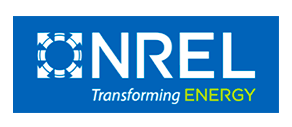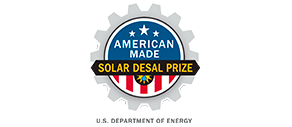IDA -NREL Second Phase Quarterfinalist Teaming Webinar for the American-Made Challenges: Solar Desalination Prize
IDA – NREL Second Phase Quarterfinalist Teaming Webinar for the American-Made Challenges: Solar Desalination Prize
Thursday October 28, 2021, 12 Noon EST, USA
This Teaming Event allows potential partners to network with quarterfinalist teams from the Innovation Contest in an effort to form cross-cutting teams capable of building a fully operational prototype of their innovations. Attendees will learn about the winning submissions and hear from keynote speaker, Gavin van Tonder, water sector head of NEOM.
Agenda
12:00 – 12:10
Welcome Remarks
- Ms. Shannon K. McCarthy, IDA Secretary General, USA
- Mr. Daniel Zimny-Schmitt, Prize Administrator at National Renewable Energy Laboratory, USA
- Mr. Shane Powers, Technology Manager at Department of Energy, USA
12:10 – 12:25
Keynote Speaker
- Mr. Gavin Van Tonder, Water Sector Head, NEOM
Session Moderator: Ms. Shannon K. McCarthy, IDA Secretary General
12:26 – 12:30
Team Captain: William Guiney
Artic Solar: Engineered Solar-Thermal Osmosis
Location: Jacksonville, FL
This concept is an integrated solar-thermal desalination system that combines a non-tracking collector with a forward-osmosis desalination module. The technology uses a thermally responsive solvent, which draws water from a brine stream across a membrane. The solvent is then heated to separate it from the generated fresh water.
12:31 – 12:35
Team Captain: Aaron Baskerville-Bridges
AeroShield: Transparent Aerogels to Improve Solar Thermal
Location: Cambridge, MA
AeroShield is developing super-insulating, transparent silica aerogels to improve the performance of solar-thermal receivers by up to 40%. These aerogels could maximize solar transmittance while minimizing heat loss, improving the performance of concentrating and non-concentrating (flat-plate) solar collectors that can deliver heat to solar-thermal desalination systems.
12:36 – 12:40
Team Captain: Brandon Hathaway
Sunvapor: Solar Cascading Evaporation Process
Location: Pasadena, CA
This technology takes in and treats brine using thermal energy from low-cost solar steam. Brine sources may be reverse-osmosis waste, power plant cooling towers, or other waste streams with high salt content. A steam accumulator discharges steam to provide thermal energy storage to support low- and high-temperature desalination processes. In the high-temperature stage, the accumulator uses a thermocompressor, which uses thermal energy to compress the steam, and in the low-temperature stage it uses a membrane distillation process.
12:41 – 12:45
Team Captain: Jon Czas
Team Trident: TSSE-ZLD Treatment of Produced Water
Location: Santa Barbara, CA
This concept aims to reduce the cost of treating high-salinity brines produced from oil and gas extraction by using a multi-stage temperature-swing solvent extraction technology for zero liquid discharge (TSSE-ZLD). This technology swings from high to low temperatures to extract water from brine. By using low-grade thermal heat to drive TSSE’s separation and solvent regeneration processes, the technology advances a non-evaporative, non-membrane solar-thermal desalination concept, which can be implemented at low cost.
12:46 – 12:50
Team Captain: Alexander Mednick
Physical Sciences: Modular Inexpensive Solar Thermal Evaporative Desal
Location: Andover, MA
Physical Sciences has developed an integrated solar-thermal collector and desalination system to produce low-cost fresh water for small- to medium-scale systems (that produce 100 cubic meters daily or less). This concept has individual concentrating solar-thermal modules with glass receiver tubes in which salt water is distilled by multi-stage flash—a process that boils water to make steam, which is condensed and collected as fresh water. The goal is to combine the low-cost simplicity of a solar still with the thermal efficiency of multi-stage flash to reduce complexity and materials costs compared to traditional, high-temperature concentrating solar-thermal power equipment.
12:51 – 12:55
Team Captain: Gyoung Gug Jang
ORNL Solar Desalination: Modular Intensified Solar-Desal Technology
Location: Oak Ridge, TN
Researchers from Oak Ridge National Laboratory will produce fresh water from high-salinity water, with zero liquid discharge so that easily disposable salt is the only waste product, using a black graphite foam as a solar energy absorber and heat conductor. The graphite directly heats up salt water to produce fresh-water vapor, and by using a superhydrophobic coating on the surface of internal channels to repel water, this can be efficiently coupled to high-efficiency membrane distillation process, without requiring a heat-transfer fluid or electrical-to–thermal energy conversion.
12:56 – 13:00
Team Captain: Lun Jiang, CEO
Winston Cone Optics: Portable Optics for Solar Heat
Location: Merced, CA
Winston Cone Optics has developed a low-cost, compact solar concentrator designed to minimize system capital costs, complexity, and operations and maintenance costs of a solar desalination collector system. It is designed to be quickly deployable and portable, allowing solar-thermal water-treatment systems to enter niche markets that need seasonal or multi-site applications. Unlike traditional solar-thermal collectors, this concept does not require tracking and tilting to perform well. It also allows modules to be installed next to each other, without casting shade, so they can fit in limited areas.
13:01 – 13:05
Team Captain: Bennett Widyolar, CTO
Winston Cone Optics: Integrated Compound Parabolic Concentrator
Location: Merced, CA
Winston Cone Optics has developed a non-tracking solar-thermal collector called the integrated compound parabolic concentrator (ICPC) for process-heat applications up to 150°C. The ICPC is designed to maximize solar-to-thermal efficiency, with limited or no tracking, through a silver coating that reflects light toward an aluminum mini-channel absorber. The absorber has a selective coating that maximizes solar absorption and minimizes thermal emissions. As a result, the ICPC has the potential to heat fluids at more than 50% solar-to-thermal efficiency.
13:06 – 13:10
Team Captain: Craig Anderson
Planet A Energy: Solar Heat Collector with Built-in Storage
Location: Pasadena, CA
This system couples a low-cost solar collector with a directly heated low-cost thermal energy storage material. The collector, absorber, and energy storage are integrated into one module, eliminating many system complexities associated with traditional concentrating solar-thermal power. The design uses an inert solid material as both an absorber and a storage medium. It provides integrated long-duration storage for around-the-clock operation for solar-thermal desalination and other process-heat applications.
13:11 – 13:15
Team Captain: John Floyd
SolMem: Solar NZLD
Location: Houston, TX
This concept combines a solar-thermal-driven multi-effect membrane distillation (MD) process with electricity-powered reverse osmosis (RO) to desalinate various wastewater streams and produce drinking-quality water. The MD technology uses a nanophotonics-enabled photothermal membrane that converts light to heat to simultaneously collect solar energy and desalinate water. This improves thermal efficiency and water recovery compared with conventional MD. The conceptual hybrid system combines the low energy consumption of RO with the high salt tolerance of MD while mitigating the disadvantages with near-zero liquid discharge (NZLD) so salt is just about the only waste product.
13:16 – 13:20
Team Captain: Nick Probert
D&D Manufacturing: Concentrated Solar Multi Effect Distillation
Location: Fletcher, NC
D&D Manufacturing and Low Impact Technologies USA Inc. are working together to develop a solar-thermal multi-effect distillation (MED) process that can handle a wide range of input brine salinities. The team developed a low-cost, thermoplastic parabolic trough that provides heat to a solar-thermal desalination process. Thermoplastic allows for a more precise trough design because it can be melted, then molded. The trough acts as both the solar collector and a horizontal distillation column. The system is designed to recapture the heat of vaporization of the produced water vapor to maximize thermal efficiency. This technology is modular, scalable, and can potentially support zero-liquid discharge requirements for various applications.
13:21 – 13:25
Team Captain: Ted Ground
Frontier Research Group: Clouds & Rain: Optimum Solar Thermal Desalination
Location: San Marcos, TX
Frontier Research Group is developing a humidification-dehumidification (HDH) approach to desalination with a combination of technologies designed to optimize solar-thermal desalination over a range of salt concentrations. This concept significantly enhances the HDH process by creating sub-millimeter microbubbles with hot air, called sparging. Solar energy directly heats air and salt water through a compound parabolic concentrator. Then the air and salt water are mixed to improve heat transfer and evaporation. To collect fresh water, condensation is enhanced with advanced materials that form superhydrophobic structures, which repel water. This combination of technologies is a novel design that could be used in various solar-thermal desalination markets.
13:25 – 13:30
Closing Remarks and Introduction to the Networking Session
Mr. Daniel Zimny-Schmitt, Prize Administrator at National Renewable Energy Laboratory
13:30 – 15:00
Networking sessions
Subscribe to stay informed
Shortest way to explore what’s happening in IDA and the global advanced water treatment community
Click here to change this text




